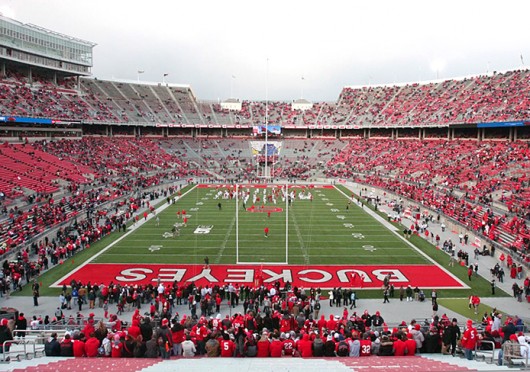
Ohio Stadium during an OSU football game against Indiana Nov. 23. Ohio Stadium is set to receive waterproofing and concrete repairs this summer.
Credit: Shelby Lum / Photo editor
The Ohio Stadium is set to receive waterproofing and concrete repairs this summer, a project that has increased in cost by $500,000 since its approval by the Board of Trustees in 2012.
Repairs are set to include removing and replacing the existing waterproofing membrane, expansion joint seals and sealants — which are in place to relieve stress on building materials caused by factors like temperature changes and wind — and repairing some concrete in the stadium.
The project has two parts, athletics spokesman Dan Wallenberg said in an email, and an issue was discovered during the first part.
“During phase one, after removing the existing waterproofing membrane, it was learned that additional work would be required to level the surface of the concrete to ensure the performance and guarantee of the new membrane,” Wallenberg said.
The additional cost of that work brought the new total of the project to $4.8 million from $4.3 million, slated to come from athletics department reserves, Wallenberg said.
A construction project on the stadium during Spring Semester last year moved the 2013 OSU football Spring Game to Paul Brown Stadium in Cincinnati. That project, which cost $4.3 million, was a routine maintenance project that occurs every 10 to 15 years, involving recoating the concrete in order to waterproof it and repairing the wear and tear on the concrete and construction joints.
Michael Denney, a third-year in chemical engineering, said despite his initial reaction to the cost increase, he thinks the price tag is worth it.
“When I initially saw that the re-evaluation elevated the cost (of) the stadium repairs $500,000 I was shocked,” he said. “But the more I thought about it, the less stressed I was about it. Actually I’m glad that in their re-evaluation of the stadium that they caught that they would need to make additional repairs. The ‘Shoe has been here forever it seems and we are obligated as a university and student body to take care of it.”
Denney also said it’s “imperative” that the infrastructure is maintained and sound in order to accommodate game attendees.
The current project isn’t the only one in the works at the stadium.
New seating and lighting are also expected to be completed in time for the start of the 2014 football season.
That project is set to cost the Department of Athletics $8.9 million, Wallenberg said.
Construction is expected to be completed by August, Wallenberg said, in time for the first home football game Sept. 6 against Virginia Tech.
Nearly 2,500 student seats are slated be moved from the north end zone C-deck to the south stands. The project’s completion is set to result in 18,900 total student seats in the south stands and 9,400 at the north end. Permanent light installations on top of the stadium are also to be added.
Jake Bradley, director of football operations for Block “O,” said he’s excited for the stadium seat-expansion project and to see the changes it will bring the stadium.
“This project will enhance the student experience at football games by uniting more students in the south stands and creating an even better atmosphere for college football,” said Bradley, a fourth-year in public affairs and geography.
Denney said he understands some could be miffed by more construction, but he thinks it is worth it.
“Since my freshman year, there has been nothing but construction on campus, what’s a little more going to hurt?” Denney said. “It just shows that we are constantly improving our facilities.”


